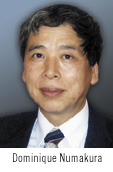
The DVD format war is on, with Sony and Toshiba slugging it out.
In previous columns I spoke about the leading electronic manufacturers in Japan and Korea developing the next generation of DVD systems. Two basic systems are being proposed as the future standard for the next DVD generation. Sony presented its Blue Ray Disc (BD) as a high-performance system and Toshiba presented HD-DVD as a high-cost performance system. The two groups were involved in talks aimed at adopting one common compatible system; unfortunately, neither party will compromise so there is little chance to have a common standard for the next DVD generation.
Last week, Toshiba's first commercial entry for the next generation of DVD players was unveiled. Toshiba said the new HDTV needs the new DVD system and customers want the new DVD system as soon as possible. Samsung Electronics will introduce its commercial BD product sometime in May or soon after. Sony's plan to roll out Play Station III using the BD technology is on hold until November. Toshiba hopes its HD-DVD is the de facto standard for the next DVD generation.
The marketplace may not be eager to adopt the new standard. Even though it's been 25 years, consumers still remember the video players and the two choices available: Panasonic's VHS and Sony's Betamax. Sony wanted the high-performance Betamax to be the de facto standard, while Panasonic organized many companies to make its VHS the actual standard. Sony customers were forced to buy another VHS player along with more software.
Several industry analysts commented that consumers will wait for this new war to be over, with a clear winner decided, before buying the next generation of DVD players.
Component and circuit board suppliers don't care which side wins. They hope the new products will generate market demand for components and circuit boards as soon as possible.
Look at the MP3 player market, which has a clearly defined market leader. Apple computer created a unique idea with its iPod and it became the de facto standard. The MP3 market has shown significant growth over a short period of time. Unfortunately, there is no leading company with a unique idea where the next DVD generation will be born. There is little chance that a common industry standard will be adopted in the near future; therefore, the next DVD generation will not stimulate a short-term demand spike for component and circuit board suppliers.
Headlines
Ulvac, an equipment manufacturer in Japan, will invest 2 billion yen to expand the plant of LCD manufacturing to 7,200 meters2 for ODF machines.
Citizen Watch, a watch and clock manufacturer in Japan, has been increasing the production of glass base disc substrates for the booming micro drive application market, targeting 3 million discs per month by 2008.
Murata, a passive component supplier in Japan, has commercialized a new low height chip inductor (0.7 mm tall) for DC/DC converters for RoHS-compliant cell phones.
The Semiconductor Industry News' top 10 device manufacturers in Japan will invest 323 billion yen in 2006 to cover the growing demands.
Fujitsu has developed a new 2.5" disc drive MHV2200BT with 200 GB memory capacity for high-end personal computers.
Flex circuit supplier Nitto Denko will invest 10 billion yen in a new manufacturing plant for high-density flex circuits used in driver modules for display devices. Twenty micron pitch traces will be produced by a semi-additive process.
Seiko Epson, an electronics company in Japan, unveiled a new technology for the flexible semiconductor technology. Transistor type organic FeRAM devices were formed on a thin plastic substrate. The company has also developed the world's smallest WLP for gate array devices: 2.42 mm square.
Fuji Electric will invest 40 billion yen to double the manufacturing capacity for hard discs, to 14 million discs per month, in Japan and Malaysia.
NGK, ceramic product supplier in Japan, will invest 30 billion yen to found a new plant for IC packaging. The new plant will start the production in June 2007.
Taiyo Yuden, a capacitance supplier in Japan, has sold its U.S. power supply business to Tamura Seisakusho.
Matsushita Electric Works, the largest PCB material supplier in Japan, has developed a new coverlay film for high-density flexible circuits without halogen molecules.
NOK, parent company of the major flex manufacturer in Japan, has transferred the market division of its flexible circuit business to Nippon Mektron.
Toray Engineering has rolled out FS 2500N, a new flip chip bonding system, with underfill injector for small pitch substrates.
Taiyo Industrial, flex circuit and inspection machine vendor in Japan, has opened the second office in China to expand the business of the inspection machines and the prototype business of flexible circuits. The prototype business in Japan has been rebounding since the end of 2005.
Patrite, a device supplier in Japan, will co-found a new joint venture, PH Electronics, with Hikami Seisakusho for packaging and assembling PCBs.
Tashiro Denka, a plating shop in Japan, will install a new thick electroless Au/Ni plating line, doubling capacity to 240 meters2 per day. The demands of IC substrates have been growing recently.
Panasonic Electronic Devices and Doshisha University have co-developed a new high-quality audio speaker using natural fibers made from bamboo.
Dominique Numakura is president of DKN Research; This email address is being protected from spambots. You need JavaScript enabled to view it..












